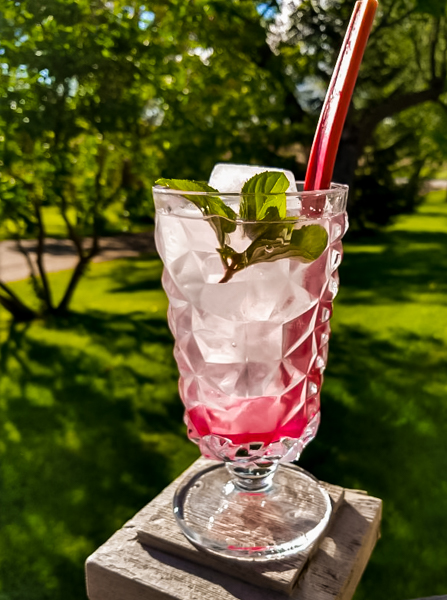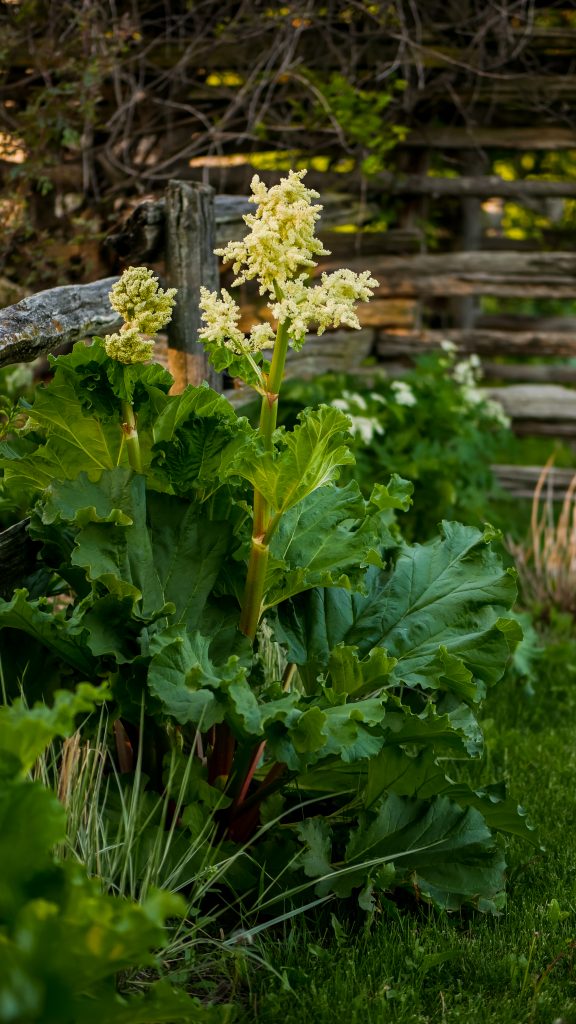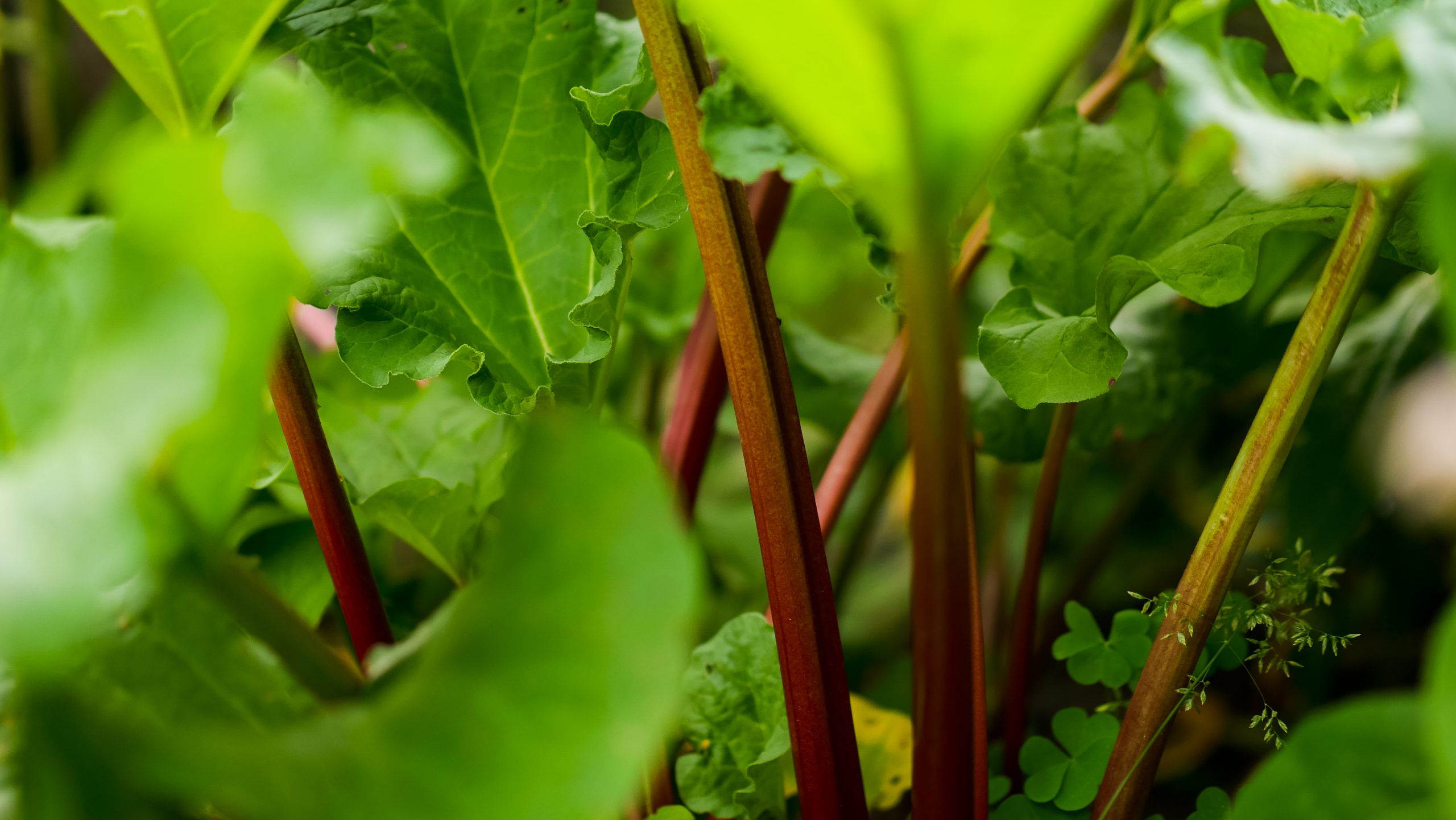Rhubarb Shrub Recipe and Companion Plants
The Mighty Plant: Rhubarb!
Just say the word Rhubarb, and childhood memories come flooding back! My sister and I barefoot in the garden on a sunny morning, with a tin cup of sugar, picking just the right piece of rhubarb for our tasty spring treat. Ah that first bite, crunch! Oh so tart! then dip, and oh, so sweet! We waited all year for these special garden moments
Rhubarb is most often thought of as a vibrant fruit because of its sweet, tart taste, and is often found in home baking, such as a rhubarb pie, but did you know that it’s actually a vegetable? Cross my heart! Come to think of it, there is a strong resemblance to celery. While technically it is a vegetable, legally it’s considered a fruit due to a 1947 court ruling in America. Interesting eh?
Rhubarb, part of the Polygonaceae family of plants (perennial), is a unique looking plant with a remarkably interesting history. The rhubarb plant was originally used in many forms of traditional medicine, first showing up in Europe over 400 years ago. It’s fascinating to share that there are records showing rhubarb among the medicines traded along the Silk Road. Scientifically, it is an herbaceous perennial with leaves growing off the top of a thick rhizome. The leaf stalks and seeds are the only parts of the plant consumed. The heart-shaped, wide-veined leaves contain oxalic acid, which can be toxic when consumed in large quantities, so discard them before you use or store the stalks. As a gardener I love the beautiful addition rhubarb offers the landscape thanks to these large leaves and colourful stalks.
Harvesting
Rhubarb season runs from April through June. When harvesting, the stalks are carefully pulled or cut from the rhizome, and the toxic leaves are removed right away. Plants can generally be harvested for a four-week period in the third year and for around eight to 10 weeks in subsequent years.
How to Freeze Rhubarb? Simply pick and chop off the leaves, wash and pat dry the stalks. Chop into small even pieces. Put in a freezer bag and empty it of all the air (I measure 4 cup amounts because this is how much we need to bake a 9 inch pie). Put in a freezer and use throughout the year. Make sure to thaw and drain the frozen rhubarb before using it!
So, What is a “Shrub” Anyway?
It sounds all fancy dancy, but a Shrub is a super easy way of preserving fruit. Before we had refrigerators, our grandmothers were using many ways to preserve nature’s bounty. Canning, curing, smoking and dehydrating (which all sound very familiar) , but shrubs – also known as drinking vinegar – might be something new to you. A shrub is just a simple fruit syrup fortified with vinegar instead of water for preserving the essence and flavour of the plants being used. The vinegar continues to work with the sugars, and over time, creates a twist … mellowing and melding into a wonderful concoction. The tangy rhubarb shrub can be added to water, mineral water, sodas, or spirits for a refreshing tart drink. I also like to add a kick of ginger or some heavenly mint from the garden! Be inventive; try adding a splash of fruit juice, herb and spices to make a new drink each time.
Shrubs were popular during 1600s, 1700s and 1800s and has been making a come back for some time. Now appearing in specialty shops being used most commonly in craft cocktails, or mocktails. I LOVE the saying, “everything old is new again”. Ain’t that the truth!
This traditional treat is welcomed on a hot summer day or makes a lovely gift!

My Mom’s Rhubarb Shrub Recipe
Ingredients:

- 6 cups of freshly picked Rhubarb
- 1 ½ tsp dried ginger (optional)
- ¾ cup apple cider vinegar (can also use white or red wine vinegar or water)
- 3 hand sized pieces of Sweet Cicely leaf
- ¾ cup sugar (if not using Sweet Cicely, sugar should be 1 ¼ cups)
Directions
Wash rhubarb and sweet cicely. Combine chopped rhubarb, sweet cicely, sugar, ginger, and vinegar in a medium saucepan. Cover and bring to a boil over medium-high heat. Once boiling reduce heat to low. Cook, stirring occasionally, until rhubarb is completely broken down and strands are visible, 15 minutes.
Use a fine mesh sieve or colander lined with cheese cloth and strain mixture into a glass container. Let cool and then chill.
Voila! Shrub is ready to use.
For a refreshing drink simply add 1/8th cup (1 oz) of shrub to the bottom of a tall glass, fill with ice and top with water or sparkling water. Top with a mint leaf and small stalk of rhubarb. Optional: add a splash of juice, vodka, gin, gin smash or Tom Collins.
** Note: Any left over rhubarb can be frozen for later use. I always pick extra and bag up 4 cups of cut rhubarb with a leaf of sweet cicely for baking a pie or crisp when rhubarb is out of season.
Companion Plant Pairings for Your Garden: Rhubarb and Sweet Cicely
Plants grow better with a little help from their friends. The practice of planting different varieties of plants together is known as companion planting and can help ensure a healthy harvest of both crops. Rhubarb and Sweet Cicely are a perfect pair. They have been growing harmoniously side by side in my old vegetable garden for years. But the best part is they are ready at the same time! They are a delight to any gardener who loves Rhubarb but does not want a ton of sugary desserts. Sweet Cicely helps you to cut the amount of sugar in any given recipe by almost half. AMAZING!
Other kitchen pairings:
Sweet shrubs: strawberries or blackberries with mint, sweet cicely seeds with pineapple, or peaches with basil.
Savory shrubs: tomato shrub infused with chilies and cilantro, cucumber with fresh ginger, or celery and caraway seeds.
Medicinal Information
Sweet Cicely
- Aromatic, stomachic, carminative and expectorant. Possible diuretic
- Useful in coughs and pleurisy
- Gentle stimulant for debilitated stomachs. Useful in flatulence
- The fresh root may be eaten freely or used in infusion with brandy or water. A valuable tonic for girls from 15 to 18 years of age
- The roots are antiseptic, and a decoction is used for bites of all kinds through bugs to animal
- The essence to be aphrodisiac
- The decoction of roots in alcohol is also said to be effective for consumption
- Ointment made eases the pain of gout
Rhurbarb
- Eases digestion: the fiber in rhubarb promotes a healthy and normal digestion process and eases abdominal discomfort such as bloating and cramping
- Bone health: the vitamin k, combined with the rich amount of calcium and other minerals found in rhubarb, promote bone protection and strengthening. The high amounts of vitamin K also promotes osteotropic activity, meaning that it stimulates bone growth and repair
- Brain health: protecting the brain from neurological damage and disorders, such as Alzheimer’s
- Antioxidant: fights free radicals and keeps inflammation in check
- Relieves constipation and diarrhea: as it eases digestion, it can also relieve constipation and diarrhea
- Lowers Inflammation: the antiviral effects of rhubarb also help inhibit inflammation, making it an effective anti-inflammatory
- Aides Perimenopause and Menopause symptoms such as hot flashes.
- Menstrual cramps
- Nutrient: containing calcium, vitamin K, A and C, potassium and manganese.
- Weight loss: rhubarb is very low in calories and the high fiber content helps you feel full faster
- Heart Diseases: the high fiber content is extremely useful in lowering cholesterol levels



